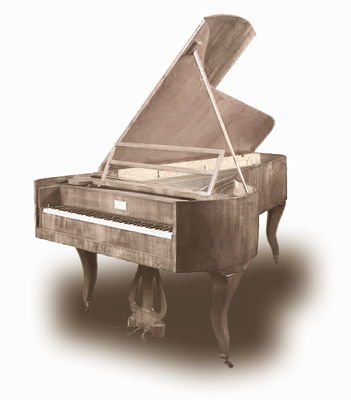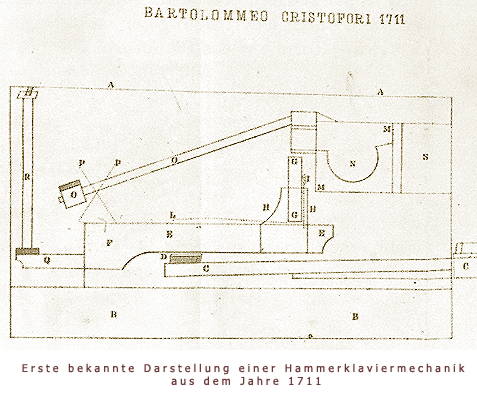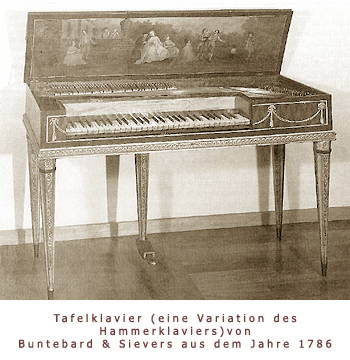 "The
fortepiano distinguishes itself from a modern piano in several respects: Among
other things, it has a much less complicated mechanics than the modern piano.
The modern piano was developed in the course of a changed aesthetics, to enable
an as great as possible sound. As a result, many subtle shades of expression
were lost. Indeed, a fortepiano
does not sound as loud as a modern piano, but
instead one has the feeling as a pianist, that the fingers control the strings
more directly. This facilitates a subtler performance of, among other things,
articulation, than modern pianists generally are used to. There are hardly any
dynamic signs in Mozart and Haydn's
expression marks, like forte, piano, crescendo,
diminuendo and so forth, instead articulation slurs abound. In the case of
Mozart and Haydn’s music, one ought to express accents through articulation and
not so much through dynamics. If the finger lets go of the previous key before
playing the next one, the listener hears the next tone as accentuated.
"The
fortepiano distinguishes itself from a modern piano in several respects: Among
other things, it has a much less complicated mechanics than the modern piano.
The modern piano was developed in the course of a changed aesthetics, to enable
an as great as possible sound. As a result, many subtle shades of expression
were lost. Indeed, a fortepiano
does not sound as loud as a modern piano, but
instead one has the feeling as a pianist, that the fingers control the strings
more directly. This facilitates a subtler performance of, among other things,
articulation, than modern pianists generally are used to. There are hardly any
dynamic signs in Mozart and Haydn's
expression marks, like forte, piano, crescendo,
diminuendo and so forth, instead articulation slurs abound. In the case of
Mozart and Haydn’s music, one ought to express accents through articulation and
not so much through dynamics. If the finger lets go of the previous key before
playing the next one, the listener hears the next tone as accentuated.
Many contemporary pianists neglect this, because of the ponderous mechanics of
the modern piano. However, in this kind of music, constant dynamic accents
sounds often very coarse. A further difference consists in the much shorter tone
of the fortepiano compared to the modern piano. This explains why the handed
down metronome marks in the case of slow movements - e.g. from Beethoven -
appear to modern pianists generally too fast. The tone of the modern piano has a
slower decay and therefore encourages slower tempi.

Furthermore, the modern piano builder considers it a virtue if all registers of
the piano have the same tone quality, meanwhile previously, fortepiano builders
wanted consciously that the different registers of the piano have a different
tone quality, somewhat imitating a string quartet.
Whoever
has learned to play on historical instruments, can use the acquired knowledge
when performing on modern pianos."
 "The
fortepiano distinguishes itself from a modern piano in several respects: Among
other things, it has a much less complicated mechanics than the modern piano.
The modern piano was developed in the course of a changed aesthetics, to enable
an as great as possible sound. As a result, many subtle shades of expression
were lost. Indeed, a fortepiano
does not sound as loud as a modern piano, but
instead one has the feeling as a pianist, that the fingers control the strings
more directly. This facilitates a subtler performance of, among other things,
articulation, than modern pianists generally are used to. There are hardly any
dynamic signs in Mozart and Haydn's
expression marks, like forte, piano, crescendo,
diminuendo and so forth, instead articulation slurs abound. In the case of
Mozart and Haydn’s music, one ought to express accents through articulation and
not so much through dynamics. If the finger lets go of the previous key before
playing the next one, the listener hears the next tone as accentuated.
"The
fortepiano distinguishes itself from a modern piano in several respects: Among
other things, it has a much less complicated mechanics than the modern piano.
The modern piano was developed in the course of a changed aesthetics, to enable
an as great as possible sound. As a result, many subtle shades of expression
were lost. Indeed, a fortepiano
does not sound as loud as a modern piano, but
instead one has the feeling as a pianist, that the fingers control the strings
more directly. This facilitates a subtler performance of, among other things,
articulation, than modern pianists generally are used to. There are hardly any
dynamic signs in Mozart and Haydn's
expression marks, like forte, piano, crescendo,
diminuendo and so forth, instead articulation slurs abound. In the case of
Mozart and Haydn’s music, one ought to express accents through articulation and
not so much through dynamics. If the finger lets go of the previous key before
playing the next one, the listener hears the next tone as accentuated.
